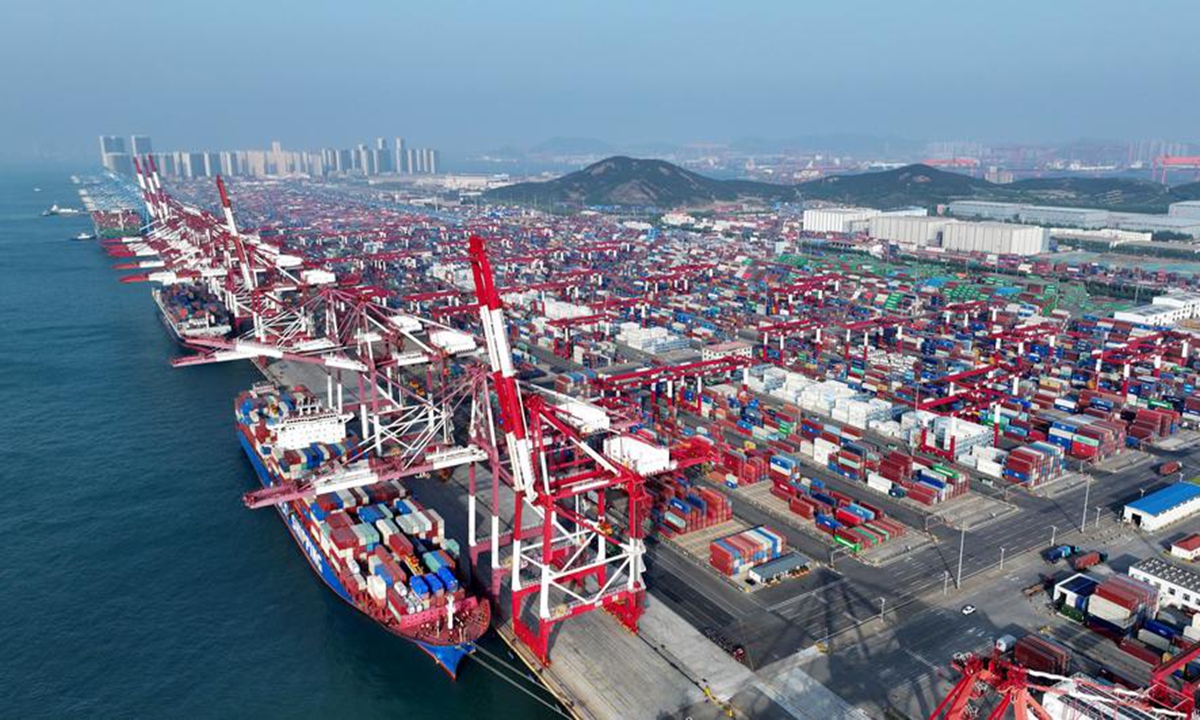Research shows China leads US as SE Asia's 'most influential partner'; experts attribute it to region's pursuits aligning with China's devt ideals

An aerial drone photo taken on April 30, 2025 shows cargo ships berthing at a container dock of Qingdao Port in Qingdao, east China's Shandong Province. This year, Qingdao port has actively expanded its international shipping routes, especially for the Association of Southeast Asian Nations (ASEAN). Photo: Xinhua
New research by the Australian-based Lowy Institute shows that China retains a very narrow edge over the US as Southeast Asia's most influential partner, with experts predicting it will soon pull further ahead, Australia's ABC News reported on Thursday. A Chinese expert said that Southeast Asia's pursuit of certainty aligns with China's development philosophy and needs.
The institute's 2025 South-East Asia Influence Index noted that China has an overall influence score of 65 out of 100, a one-point lead over the US. It is the most influential power in six out of the eleven Southeast Asian countries - Cambodia, Indonesia, Malaysia, Myanmar, Thailand and Vietnam.
With economic influence as Beijing's "strongest card" in Southeast Asia, the research noted China is the region's leading export market — taking around 20 percent of all exports, compared to 16 percent going to the US — and is responsible for around 26 percent of the region's imports.
It is also the region's top diplomatic partner, maintaining an extensive network of embassies and keeping up a steady tempo of high-level political engagement across the region, ABC News reported.
However, the Lowy Institute's Susannah Patton said China lagged in other areas, trailing the US in cultural influence and maintaining relatively weak defense networks across Southeast Asia, per the ABC report.
China's deepening economic engagement in Southeast Asia, particularly as primary trading partner, has strengthened ties through multiple cooperation agreements, Chen Hong, director of the Asia-Pacific Studies Center at East China Normal University, told the Global Times. By leveraging trade advantages, China has become a key driver of Southeast Asia's economic growth, Chen said.
While the US is trailing only just behind China in terms of its influence, Patton said US influence in the region was already eroding, and that the US' moves to hit Southeast Asia with hefty tariffs — while slashing foreign aid and tightening migration — would accelerate the region's drift towards China, the report by ABC News noted.
The widening gap in influence between China and the US in Southeast Asia can be attributed to three major external objective factors, said Ge Hongliang, deputy director of the College of ASEAN Studies at Guangxi University for Nationalities.
Emerging countries are rising while the West is relatively declining, Ge said, adding that as an important part of the Global South, Southeast Asia actively supports multilateralism and globalization, seeking certainty, which aligns with China's development philosophy and needs.
Also, US policy toward Southeast Asia has long been characterized by ambiguity and uncertainty, and the escalation of hotspot issues in various parts of the world has widened the divergence between Southeast Asian countries and the US on certain positions, Ge added.
Compared to the US, Chen said that China's approach to economic engagement is more inclusive, encompassing not only trade but also substantial investment and cooperation. Grounded in principles of equality and mutual benefit, this approach has delivered tangible benefits to Southeast Asian countries.
Facing the uncertainty and short-term nature of US policies, Southeast Asian countries prefer a more stable and strategically significant long-term partner, Chen also emphasized.
Ge also noted that the research released by the institute relies heavily on secondary data and adopts a binary perspective, focusing primarily on comparing the dominance of China and the US in the region while overlooking ASEAN's own influence.
In fact, ASEAN has developed rapidly in recent years and gained increasing prestige. The principle of ASEAN centrality remains a key starting point for its member states' external interactions and cooperation, Ge added.
Photos
Related Stories
- "Air Silk Road" cooperation to accelerate China-ASEAN trade: aviation sector experts
- Promotional event highlighting China-ASEAN Silk Road cross-border e-commerce open cooperation held in Guangxi
- China, ASEAN pledge to strengthen AI cooperation
- Over 500 economic, trade deals inked at China-ASEAN Expo
- China Buzz: Mind-blowing AI tech at China-ASEAN Expo
Copyright © 2025 People's Daily Online. All Rights Reserved.









